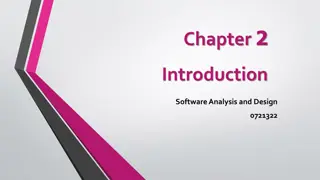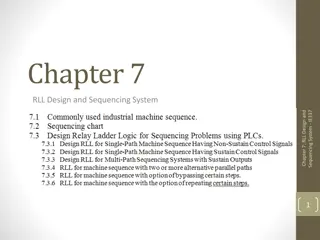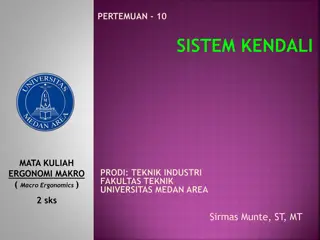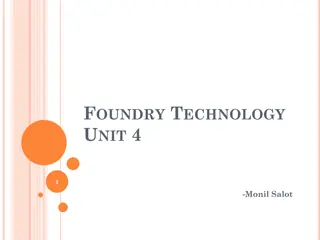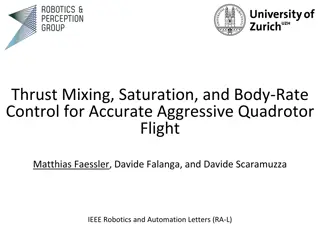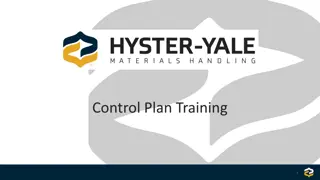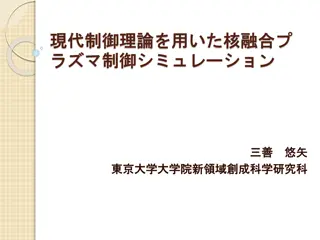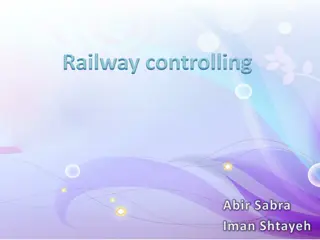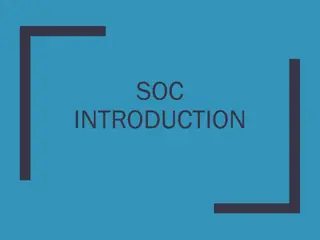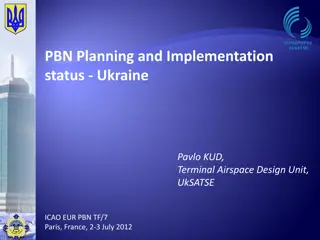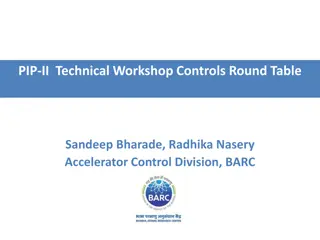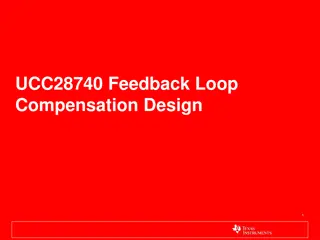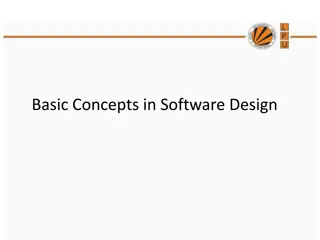Advanced Topics in Control System Design and Implementation
Delve into the complexities of control system design, from system identification to modern control techniques. Explore the challenges of designing controls for systems like interferometers and discuss the integration of classical and modern control theories. This workshop offers insights on optimal feedback, noise feedforward, interferometer stability, and next-generation control system architecture. Participants can contribute to shaping the workshop agenda based on their interests, potentially covering topics such as robust controls and fault-tolerant systems.
Download Presentation

Please find below an Image/Link to download the presentation.
The content on the website is provided AS IS for your information and personal use only. It may not be sold, licensed, or shared on other websites without obtaining consent from the author.If you encounter any issues during the download, it is possible that the publisher has removed the file from their server.
You are allowed to download the files provided on this website for personal or commercial use, subject to the condition that they are used lawfully. All files are the property of their respective owners.
The content on the website is provided AS IS for your information and personal use only. It may not be sold, licensed, or shared on other websites without obtaining consent from the author.
E N D
Presentation Transcript
GWADW Controls Sessions we make it look easy, but G1500663-v1 GWADW Controls Sessions introduction
Opening Comments Controls are fundamentally different from the other session topics Difficult to discuss controls for a system/interferometer which has not been designed (barely conceptualized) While control considerations are integral to system design trade-offs, these considerations are generally simple & fundamental (observability/controllability, sensor/actuator locations, bandwidth, ) We assume (correctly, I think) that if you build it, they will control it control system design must be integral in the detailed design phase Our control synthesis has been (generally) based on classical control theory Can we benefit from Modern controls? Can we benefit from the recent AI successes (e.g. deep learning)? G1500663-v1 GWADW Controls Sessions introduction
Controls Sessions A Tue 9:00-10:30 System identification and modern Control B Tue 11:00 12:30 Optimal feedback C D Wed Tue 4:00 6:00 9:00 10:30 Noise feedforward and subtraction Lock acquisition problems and improvements E Wed 4:00 5:30 Interferometer stability (Keeping the IFO Lock) F Wed 6:00 7:00 Next Generation Control System Architecture Hopefully not too much scope Other topics, and sub-topics, are possible, depending upon the interests of workshop participants (e.g. robust controls, fault-tolerant controls, ....). Participants can help us shape the direction of the workshop G1500663-v1 GWADW Controls Sessions introduction
Session A: System Identification - - - - - Data and models for the controller design Transfer functions for SISO controller Matrices of transfer function for MIMO calculations Matrices of transfer functions for Diagonalization State Space model for optimal control (fitting, phase loss, right half plan zeros, high order model ) Problems - Can be time consuming - Tune parameters (Amplitude, frequency band, averages ) - Usually not optimized (Schroeder ) - SNR, Dynamic range, Saturations multiple sensors - Accuracy, coherence (fitting, model reduction, phase loss, right half plan zeros ) Goals: - Compare techniques - Exchange tools and ideas - Define goals (state of the art, explore new tools ) - Could help upgrades, next generations (early stages of testing and commissioning) G1500663-v1 GWADW Controls Sessions introduction
System identification and modern Control Coordinating/Leading discussion A Tues 9:00 10:30 1:30 Brett Shapiro Overview of System ID techniques & setting the session goals 9:00 9:15 0:15 Dennis System ID for Suspensions & Seismic Isolation Systems 9:15 9:35 0:20 Brett Shapiro 9:35 9:55 0:20 System ID at VIRGO Bas Swinkels Cross couplings in suspensions and seismic platforms Sys ID for Modern Control 9:55 10:15 0:20 Anamaria Effler Brett, Jo, Giancarlo, Manuel 10:15 10:30 0:15 G1500663-v1 GWADW Controls Sessions introduction
Session B: Optimal Control - SISO filtering versus Optimal Control We have a very good knowledge of our systems, Designed to be diagonal Extremely well instrumented, all dofs, states measured SISO is easy to debug (phase margin, gain margin ) Pole placement, high order controller (i) Optimal controllers (ii) Observers, SNR (iii) Modal control LQR: Cost function, weight Kalman filter - - - Goals: - Already investigated, good outcome, still not used, why - Prospects, application - Working groups, collaboration Partial step done G1500663-v1 GWADW Controls Sessions introduction
Coordinating/Leading discussion B Tues 11:00 12:30 1:30 Optimal feedback Dennis/Fabrice Introduction talk (review of modern control tools, state space methods, their pros and cons) 11:00 11:20 0:20 Den Martynov Discussion and comparison of classical and modern control techniques 11:20 11:40 0:20 Christophe Collette Summary of the Caltech Workshop Kalman filtering for vibration isolation Suspension Controls, including thoughts on applicability of modern controls 11:40 11:55 0:15 Gabriele 11:55 12:15 0:20 Jo van den Brand 12:15 12:30 0:15 Brett Shapiro G1500663-v1 GWADW Controls Sessions introduction
Session C: Feedforward and noise subtraction Already made the step - The standard way (rely on intuition, identify the sensor path, identify the correction path, implement) The optimal way (array of sensors, linear regression, least square minimization, Wiener ) Results already obtained - - Goals: - Where do we stand (Past results, current work) - Prospects, applications - Instrumentalist and DetChar - Automating - Adaptive G1500663-v1 GWADW Controls Sessions introduction
Noise feedforward and subtraction Gabriele Vajente C Tues 4:00 6:00 2:00 Coordinating/Leading discussion Gabriele Vajente 4:00 4:10 0:10 Introduction and setting the stage Sensor correction in seismic and suspensions 4:55 5:15 0:20 Fabrice Feed forward of auxilairy degrees of freedom 4:10 4:35 0:25 Bas Swinkels Online subtraction pipeline, and bilinear noise coupling 5:15 5:30 0:15 Keita Kawabe Feedforward at LLO and 40m, adaptive feed forward 4:35 4:55 0:20 Denis Martynov Data mining tools: hot to find channels that can be used for subtraction; how to tackle non stationary noises and couplings? Gabriele Vajente 5:30 6:00 0:30 G1500663-v1 GWADW Controls Sessions introduction
D: Lock Acquisition Problems & Improvements: description Significant time is expended in the initial stages of commissioning to discover an approach for (robust) lock acquisition Perhaps one of the biggest payoffs for control systems is in improving the nonlinear lock acquisition strategies Can learning methods be used to speed up our discovery of faster or more robust lock acquisition strategies? Can simulation, or emulation with sub-scale optical plants, be used to provide sufficient fidelity and examples for learning strategies? G1500663-v1 GWADW Controls Sessions introduction
D: Lock Acquisition Problems & Improvements: program Wed 9:00a 10:30a Session to be led/coordinated by Keita Kawabe Acquisition overview/problems & discussions LHO (Sheila Dwyer) VIRGO (TBD) KAGRA (TBD) Group discussion on common themes Mode hoping in low finesse cavities (Paul Faulda) one potential lock acquisition problem Bayesian approach to the locking problem for high finesse suspended optical cavities (Manuel Marchi and Giancarlo Cella) Noise modeling for interferometer control (Chris Wipf) focused on how noise budget modeling can be useful for locking and lock loss studies LLO (TBD) GEO (TBD) 40m Lab (TBD) G1500663-v1 GWADW Controls Sessions introduction
D: Lock Acquisition Problems & Improvements: goals/questions From each interferometer, gather a compendium of lock acquisition problems Locking metrics & statistics Discuss approaches to address each lock acquisition problem and their relative merits and success to date Are the pre-lock auxiliary systems (OptLev, ALS, TCS, ) adequate, or are improvements necessary? Shouldn t future interferometers be designed to observe and control all DOF (bounce, roll, violin modes)? Would we benefit from embedding independent sensing/actuation into the interferometers for routine diagnostic measurements & characterization? Which lock acquisition problems can & should be pursued on small scale research interferometers? G1500663-v1 GWADW Controls Sessions introduction
E: Interferometer stability (maintaining lock) description Much of an interferometer s down-time may be a result of cavity lock loss and subsequent lock re- acquisition Methods to prevent lock loss (whether due to environmental disturbance or machine 'glitches') could be very beneficial Potential causes: wind, earthquake, thermal stability, parametric instability, ... G1500663-v1 GWADW Controls Sessions introduction
E: Interferometer stability (maintaining lock) program Wed 4:00p 5:30p Session to be led/coordinated by Sheila Dwyer Overview of lock loss events/causes (Geo/Virgo/LHO/LLO) Bas Swinkles, Anamaria Effler, Keita Kawabe, Hartmut or Kate ?) Mitigation of disturbances caused by wind on the detectors (Krishna) TCS controls approaches to prevent lock loss, or mitigate the effects of lock loss (Alastair Heptonstall) LIGO/Virgo earthquake studies and controls configuration (Sebastien Biscans, in collaboration with Michael Coughlin and Paolo Ruggi) G1500663-v1 GWADW Controls Sessions introduction
E: Interferometer stability (maintaining lock) goals/questions Gather a compendium of lock loss event causes Do we have detchar infrastructure for automatic detection, logging, and calculation of statistical metrics? Discuss approaches to address each lock loss cause and their relative merits and success to date Are the lock loss prevention auxiliary systems adequate, or are improvements necessary? Would we benefit from embedding independent sensing/actuation into the interferometers for environment sensing? Which lock loss problems can & should be pursued on small scale research interferometers? G1500663-v1 GWADW Controls Sessions introduction
F: Next Generation Control System *Architecture description Explore the requirements and features of a next-generation, control system architecture supervisory controls, slow controls fast, real-time controls We need participation from real-time control system experts and commissioners *by architecture we mean everything : hardware, software, interfaces, comm. protocols, DB mgmnt G1500663-v1 GWADW Controls Sessions introduction
F: Next Generation Control System Architecture program Wed 6:00p 7:00p Session to be led/coordinated by Jamie Rollins Requirements and features of a next generation control system (Jamie Rollins) With hoped-for participation by many control system users Pros & Cons of Current Gravitational Observatory Control Systems (Rolf Bork) With hoped-for participation by many control system users G1500663-v1 GWADW Controls Sessions introduction
F: Next Generation Control System Architecture goals/questions Requirements and desired features of next generation control systems In what ways can we the GW community better collaborate/share and (possibly) migrate to a common platform, or at least common elements? What systems and technologies are emerging which show promise for future detectors? Develop a plan to explore the applicability of industrial control systems and the experience of other physics projects with modern and next-generation control systems G1500663-v1 GWADW Controls Sessions introduction
Final Comments How can we as a community share and sustain a growing expertise in the application of advanced/modern controls to GW interferometer systems? We lost the momentum from the 2014 winter workshop on advanced controls at CIT LVC working group on controls techniques? Bi-yearly (virtual) meetings? G1500663-v1 GWADW Controls Sessions introduction



